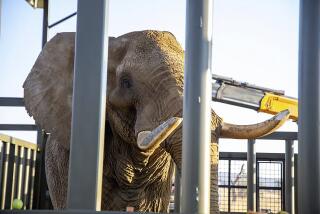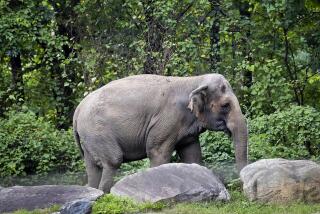What elephants can teach scientists about fighting cancer in humans
- Share via
You’ve heard that elephants never forget, but did you know they almost never get cancer either?
It turns out just 4.8% of known elephant deaths are related to cancer. For humans, cancer-related deaths are between 11% and 25%, scientists say.
The low cancer rate among elephants is particularly intriguing because, all things being equal, elephants should get more cancer than we do.
Elephants have about 100 times more cells than humans, and they live for about 70 years. That gives a lot of cells a lot of chances to mutate and become malignant over the course of a pachyderm’s lifetime.
Scientists have spent decades wondering why elephants and other large mammals don’t get cancer more often than smaller mammals. This conundrum even has a name — Peto’s paradox.
Now, new research has uncovered the secret to elephants’ cancer-fighting prowess.
In a study published this week in the Journal of the American Medical Assn., scientists reveal that African elephants have 20 copies of a gene called TP53. This gene is prized by cancer researchers because of its ability to create a protein that suppresses tumors; in fact, scientists often refer to it as the “guardian of the genome.”
Humans, on the other hand, have just one copy of TP53.
The crucial gene keeps cells safe from cancer in two ways, according to Dr. Joshua Schiffman, a pediatric oncologist at the University of Utah’s Huntsman Cancer Institute in Salt Lake City and a senior author of the study.
“When there is DNA damage, it rushes onto the scene and stops your cells from dividing so the DNA can be repaired,” Schiffman said. “It also coordinates cell death or suicide.”
Humans inherit one allele of TP53 from each of their parents, and both of them must be functional to fight off cancer. Studies show that if one of the alleles is defective, cancer is certain to develop sooner or later.
At an evolutionary biology conference, Schiffman happened to listen to a talk by Carlo Maley of Arizona State University. Maley said elephants had multiple copies of TP53, and Schiffman wondered whether they helped elephants fend off cancer.
“A light bulb went off in my head,” Schiffman said.
To find out, Schiffman and Maley teamed up with an elephant keeper at Utah’s Hogle Zoo in Salt Lake City and the chief veterinarian for the Ringling Bros. and Barnum & Bailey Circus. (The circus also contributed $250,000 to fund the research.)
One of the team’s first steps was to see just how rare cancer is in elephants. To do that, they turned to the Elephant Encyclopedia, a repository of information about elephants living in captivity all over the world. The database had details on 644 elephant deaths, and the researchers calculated that just 3.11% of those elephants had cancer when they died. Even when they assumed that all of the elephant deaths attributed to unknown causes were related to cancer, the lifetime cancer incidence came to just 4.81%.
Next, they took a closer look at the African elephant genome and tallied 20 copies of TP53. One of them was the original, and the other 19 were retrogenes that found their way into the genome over time. Their spread suggests they were preferentially selected over the course of elephant evolution, probably because they helped elephants in some way.
Perhaps they helped by fighting cancer. To see if this could be the case, the researchers collected white blood cells from elephants and humans and exposed the cells to radiation that caused their DNA to break.
The researchers expected that the elephant cells with all those extra TP53 genes would repair themselves faster than the human cells. But that’s not what they observed.
Instead, they saw that the elephant cells were dying at a much higher rate than the human cells.
While this may sound like a bad thing, it isn’t. Part of TP53’s tumor-suppression strategy is to cause a damaged cell to destroy itself so it won’t pass on potentially harmful mutations.
“It’s like the elephant said, ‘It is so important that we don’t get cancer that we can’t risk trying to repair our broken DNA and accidentally let a mutation slip by,’” Schiffman said. “It makes tremendous sense — the best way to prevent cancer in a cell is to eliminate it entirely.”
In another experiment, the researchers found that elephant cells exposed to radiation destroyed themselves at twice the rate of human cells with fully functional TP53 genes and more than five times the rate of human cells with defective TP53 genes.
“All this leads us to conclude that these extra copies of TP53 may have evolved to protect elephants from cancer,” Schiffman said. “And I say ‘may’ because the only way to know for sure is to build an elephant that has no copies of TP53” and see if it’s more vulnerable to cancer. Although researchers often breed mice that lack working copies of certain genes, “that’s not going to happen” with elephants, he said.
Trevor Graham, who studies tumor biology at the Barts Cancer Institute at Queen Mary University of London, said the findings are exciting.
“The important suggestion of this study is that additional copies of TP53 are enough to prevent elephants from getting cancer,” said Graham, who was not involved in the JAMA study. “The implication for humans is that reinforcing the protection offered by TP53 would be enough to prevent our own cells from becoming cancerous.”
Schiffman said his team would like to take what it learned from elephants and use it to help people with cancer. One possibility is to create a drug that mimics the actions of TP53. Another thought is to insert more TP53 genes into precancerous cells.
“Evolution has had 55 million years to figure this out,” he said. “We want to learn how to take advantage of that.”







